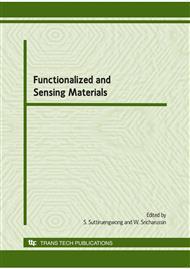p.227
p.231
p.235
p.239
p.243
p.247
p.251
p.255
p.259
Deformation of the Extracellular Matrix Due to Osmotic Pressure in Cartilaginous Tissues
Abstract:
This study is to characterize and estimate preferential flow and solute transport in soft tissue. In soft tissues, large molecules such as proteoglycans trapped in the extracellular matrix generate high levels of osmotic pressure to counter balance external pressures. The semi-permeable matrix and fixed negative charges on these molecules serve to promote the swelling and collapse behaviour of cartilaginous tissues when there is an imbalance of molecular concentrations. At the same time, the collagen fibres were a network of stretch-resistant matrix, which prevents tissue from over-swelling and keeps tissue integrity. Therefore, a simplified mathematical model is proposed, and implemented in the finite element method. Analytic solutions for solute distribution in the extracellular matrix were derived by solving under loading conditions. The results were found that the estimate with field fluctuations led to the numerical results in most cases, and significant differences were only found under conditions of highly constrained deformation.
Info:
Periodical:
Pages:
243-246
Citation:
Online since:
January 2010
Authors:
Keywords:
Price:
Сopyright:
© 2010 Trans Tech Publications Ltd. All Rights Reserved
Share:
Citation:


